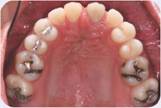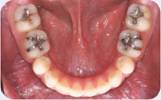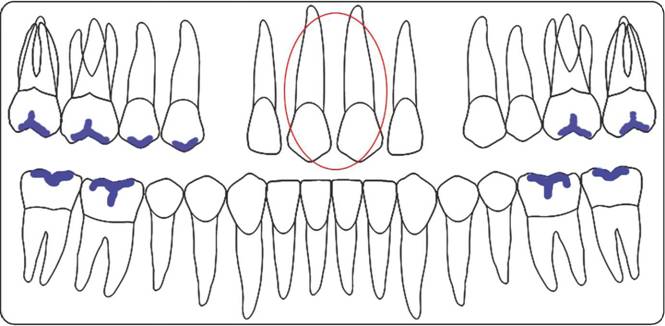
Management of a patient with maxillary canine transposition
CASE STORY
A 15-year-old Hispanic male patient presents with anterior aesthetic concerns due to clinically absent maxillary central incisors and transposed maxillary canines with lateral incisors (i.e., the patient’s maxillary canines are in the central incisor position). The patient’s chief complaint is the following: “I would like a normal smile. The kids at school call me a vampire and make fun of me.” The patient is congenitally missing the maxillary central incisors (8 and 9). He has a low caries index with several sound class I amalgam restorations. The patient’s mandibular teeth are intact.
Figure 1: Preoperative maxilla.

Figure 2: Preoperative mandible.

Figure 3: Preoperative presentation.

Figure 4: Postoperative presentation.

LEARNING GOALS AND OBJECTIVES
- To diagnose and manage transposition
- To evaluate and establish aesthetic parameters
- To establish parameters for tooth preparation for porcelain laminate veneers
- To select appropriate materials for porcelain laminate veneer therapy
Medical History
- No significant medical conditions
- Seasonal allergies
Dental History
- Regular dental visits since the age of 5 years
- No parafunctional oral habitsBrushes two times daily, does not floss, but does rinse with an over-the-counter fluoride mouth rinse
- Recently received class I amalgam restorations in mandibular molars, maxillary molars, and premolars
- Reports a “normal” diet with minimal snacking and few sweets
Medications and Allergies
- No known drug allergies
Review of Systems
- No significant findings
- Vital signs:
- Blood pressure: 110/72
- Heart rate: 72 beats/minute
- Respiratory rate: 16 breaths/minute
Social History
- Attends high school
- Smoking: denies any use of tobacco
- Alcohol: denies any use of alcohol or recreational drugs
- Denies any use of tobacco
Extraoral Examination
- Head: normocephalic, symmetric, no masses or scars
- Neck: within normal limits
- Muscles: within normal limits
- Lymph nodes: within normal limits
- TMJ: No clicks, pops, or tenderness: normal range of motion, no deviation on opening or closing
Soft Tissue Examination
- Lips: moist, symmetrical, and normal shape, size, and color
- Mucosa: pink with slight inflammation, patent Stenson’s duct, no masses, scars, or lesions
- Hard palate: normal size, shape, and rugae present
- Soft palate: normal size and shape
- Frena: within normal limits
- Tongue: Normal size and shape, no masses, scars, or lesions
- Saliva: normal flow and consistency
- Floor of mouth: within normal limits; patent Wharton’s duct; no masses, scars, or lesions
- Oral cancer screening: negative for clinical signs of oral cancer
Figure 5: Dental charting.

Charting
Clinical Findings/Problem List
- Poor oral hygiene
- Aesthetics
- Transposition—rotated and missing teeth Diagnosis
- Generalized mild gingivitis
- Transposition of maxillary canines (6 and 11)
- Missing maxillary central incisors (8 and 9)
Clinical Decision-Making Determining Factors
- Transposition is a form of ectopic eruption in which there is a positional substitution of two permanent teeth, typically within the same quadrant. There are two types of transpositions:
- Complete tr/>
Stay updated, free dental videos. Join our Telegram channel

VIDEdental - Online dental courses


